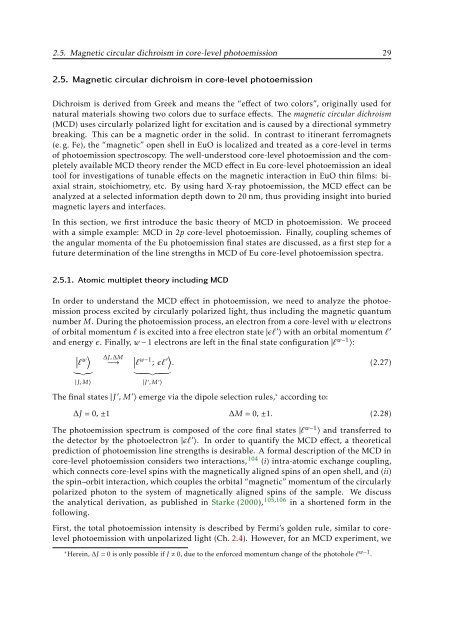Text anzeigen (PDF) - Universität Duisburg-Essen
Text anzeigen (PDF) - Universität Duisburg-Essen
Text anzeigen (PDF) - Universität Duisburg-Essen
Create successful ePaper yourself
Turn your PDF publications into a flip-book with our unique Google optimized e-Paper software.
2.5. Magnetic circular dichroism in core-level photoemission 29<br />
2.5. Magnetic circular dichroism in core-level photoemission<br />
Dichroism is derived from Greek and means the “effect of two colors”, originally used for<br />
natural materials showing two colors due to surface effects. The magnetic circular dichroism<br />
(MCD) uses circularly polarized light for excitation and is caused by a directional symmetry<br />
breaking. This can be a magnetic order in the solid. In contrast to itinerant ferromagnets<br />
(e. g. Fe), the “magnetic” open shell in EuO is localized and treated as a core-level in terms<br />
of photoemission spectroscopy. The well-understood core-level photoemission and the completely<br />
available MCD theory render the MCD effect in Eu core-level photoemission an ideal<br />
tool for investigations of tunable effects on the magnetic interaction in EuO thin films: biaxial<br />
strain, stoichiometry, etc. By using hard X-ray photoemission, the MCD effect can be<br />
analyzed at a selected information depth down to 20 nm, thus providing insight into buried<br />
magnetic layers and interfaces.<br />
In this section, we first introduce the basic theory of MCD in photoemission. We proceed<br />
with a simple example: MCD in 2p core-level photoemission. Finally, coupling schemes of<br />
the angular momenta of the Eu photoemission final states are discussed, as a first step for a<br />
future determination of the line strengths in MCD of Eu core-level photoemission spectra.<br />
2.5.1. Atomic multiplet theory including MCD<br />
In order to understand the MCD effect in photoemission, we need to analyze the photoemission<br />
process excited by circularly polarized light, thus including the magnetic quantum<br />
number M. During the photoemission process, an electron from a core-level with w electrons<br />
of orbital momentum l is excited into a free electron state |ɛl ′ 〉 with an orbital momentum l ′<br />
and energy ɛ. Finally, w − 1 electrons are left in the final state configuration |l w−1 〉:<br />
∣<br />
∣l w〉<br />
}{{}<br />
|J,M〉<br />
∆J,∆M<br />
−→ ∣ ∣l w−1 ; ɛl ′〉 . (2.27)<br />
}{{}<br />
|J ′ ,M ′ 〉<br />
The final states |J ′ , M ′ 〉 emerge via the dipole selection rules, according to:<br />
∆J = 0, ±1 ∆M = 0, ±1. (2.28)<br />
The photoemission spectrum is composed of the core final states |l w−1 〉 and transferred to<br />
the detector by the photoelectron |ɛl ′ 〉. In order to quantify the MCD effect, a theoretical<br />
prediction of photoemission line strengths is desirable. A formal description of the MCD in<br />
core-level photoemission considers two interactions, 104 (i) intra-atomic exchange coupling,<br />
which connects core-level spins with the magnetically aligned spins of an open shell, and (ii)<br />
the spin–orbit interaction, which couples the orbital “magnetic” momentum of the circularly<br />
polarized photon to the system of magnetically aligned spins of the sample. We discuss<br />
the analytical derivation, as published in Starke (2000), 105,106 in a shortened form in the<br />
following.<br />
First, the total photoemission intensity is described by Fermi’s golden rule, similar to corelevel<br />
photoemission with unpolarized light (Ch. 2.4). However, for an MCD experiment, we<br />
Herein, ∆J = 0 is only possible if J 0, due to the enforced momentum change of the photohole l w−1 .
















